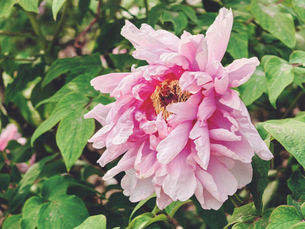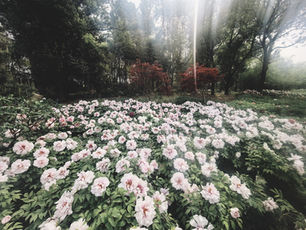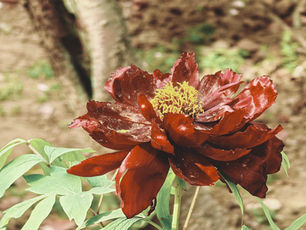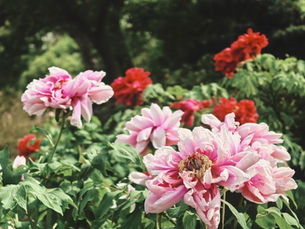Wuhan East Lake Peony Garden
Peony
King of Flowers
Tabel Of Contents
Wuhan East Lake Peony Garden: A Blooming Legacy of a Thousand Years
Nestled along the serene shores of East Lake, the Wuhan East Lake Peony Garden stands as one of Central China’s largest and most treasured floral sanctuaries devoted to the “King of Flowers.” Peony cultivation in the region traces its roots to the Sui Dynasty, flourished during the Tang and Song periods, and became an imperial symbol of prestige in the Ming and Qing eras. In Chinese culture, the peony represents wealth, honor, and national beauty. Tang poet Liu Yuxi once praised, “Only the peony embodies true national beauty, its blooming stirs the capital,” while Li Bai’s famous lines “Clouds yearn for her attire, flowers crave her countenance, spring breeze sweeps the railings, dew-drenched splendor glows” capture its unmatched elegance.
Today, the garden preserves more than a dozen century-old peony plants, living witnesses to over a millennium of history. Each spring, the grounds erupt into a sea of blossoms, blending fragrance, color, and cultural heritage into an unforgettable experience. Visitors not only admire the floral beauty but also walk through a living poem—where history, art, and nature harmonize under the gentle spring breeze.
Song Dynasty Elegance
Song literati elevated peonies to philosophical realms. Ouyang Xiu's Luoyang Peony Chronicle documented 109 varieties, establishing phenological rules like "Luoyang blooms verify the Grain Rain solar term." Su Shi's Viewing Peonies in Rain painted their ethereal beauty with "Mist-drizzles barely dotting, their hues floating between existence and void." Lu You's late-life verse "My courtyard grows peonies; even children chant the Song of Eternal Sorrow" reflected their cultural permeation. Notably, Song men wore peony hairpins as status symbols – records describe Prime Minister Kou Zhun hosting banquets where "peonies adorned every guest's hair."
Ming-Qing Legacy
The Ming-Qing era wove peonies into literary romance. Tang Xianzu's Peony Pavilion used the flower as love's metaphor, with heroine Du Liniang exclaiming "Who knows spring's glory without seeing the garden?" Pu Songling's Strange Tales featured a peony fairy's tragic love in The Silk Robe. Emperor Kangxi praised peonies as "supremely noble, making all flowers bow" in a poem for Cao Yin (grandfather of Cao Xueqin), while in Dream of the Red Chamber, Xue Baochai's "peony lot" inscribed "Even her coldness enchants" foreshadowed her floral supremacy.

Wuhan East Lake Peony Garden
Nestled by East Lake, this botanical gem is Central China’s largest peony sanctuary, boasting over 200 cultivars and 10+ centuries-old peony trees. Blending Tang Dynasty heritage with modern horticulture, its blooms stretch 35 days from March to May, outlasting counterparts in Luoyang. Visitors marvel at rare varieties like ink-black ‘Crown World Black Jade’ while tracing poetic connections to Li Bai’s verses. The garden pioneers eco-friendly cultivation, using layered soil compaction and Iot climate control. A living museum of China’s floral legacy, it merges historical charm with scientific innovation, making it a must-visit for nature lovers and culture enthusiasts alike.
History and Culture of Wuhan East Lake Peony Garden
The Wuhan East Lake Peony Garden, one of the largest specialized peony gardens in Central China, traces its planting history back to the Tang Dynasty. Known as the "King of Flowers" since ancient times, peony cultivation began in the Sui Dynasty, flourished during the Tang and Song Dynasties, and became symbolic in imperial gardens during the Ming and Qing periods. Tang poet Liu Yuxi praised its magnificence with "Only the peony embodies true national beauty, its blooming stirs the capital," while Li Bai's verse "Clouds yearn for her attire, flowers crave her countenance, spring breeze sweeps the railings, dew-drenched splendor glows" became immortal. These poetic lines not only showcase the peony's regal beauty but also reflect its unique cultural significance. The garden preserves over a dozen century-old peony plants, silent witnesses to a millennium of floral history.
Peony: Millennium Splendor in Poetic History
In the Tang Dynasty, peonies gained imperial favor under Empress Wu Zetian. Legend says when she commanded winter blooms, only peonies refused, leading to their "exile" to Luoyang – inadvertently creating the city's peony fame. Li Bai's Qing Ping Diao compared Yang Guifei to peonies with "Clouds envy her robes, flowers covet her beauty," while Liu Yuxi's verse crowned peonies as "true national beauty that stirs the capital when blooming." A rare peony plant then equaled a hundred gold pieces, with historical records noting "spring crowds madly rushing to admire them, considering it shameful not to indulge."
Poetic Symbolism
Classical peony appreciation followed "Ten Perfections": color, scent, posture, charm, sound, light, shadow, timing, setting, and vase. Bai Juyi contemplated life's transience through "Evening dews on fading petals, dawn winds through withered leaves – crimson glory fades, jade fragrance vanishes." Li Shangyang's allusion-packed verse compared peony layers to legendary beauties, while Xu Wei's self-mocking "Fifty-eight years in poverty, how dare I crave Luoyang's spring" revealed scholars' conflict: yearning for peony-like prosperity yet fearing its decadence.
Cultural Footnotes
-
Tang peony poems totaled 2,300+, constituting 41% of floral verses
-
"Yao Huang & Wei Zi" – premium peony terms from Song imperial varieties
-
Tang peony-patterned bronze mirrors in Japan's Shōsōin attest Silk Road transmission
-
The UK's Kew Gardens hosts peonies planted in 1809, genetically traceable to Li Bai's era
National Flower Significance
Though China hasn't officially declared a national flower, peonies received 78.6% votes from 18 provinces in the 1985 selection. Its cultural symbolism spans: 1) Tang Dynasty state ritual flower; 2) Song literati painting motif; 3) Yuan blue-and-white porcelain pattern; 4) Modern RMB banknote design. The Palace Museum holds 83 national treasures featuring peonies, like "Ladies with Peonies." The UN Biodiversity Convention recognizes peonies as "living cultural gene banks," with petal-extracted paeonol showing anti-inflammatory and anti-cancer properties, highlighting ecological-economic value.
Value Hierarchy
The rare peony market follows unique pricing: 1) Age coefficient (century-old ×3.8); 2) Color coefficient (black varieties ×2.5); 3) Cultural value (historically named ×1.5). At 2023 Hong Kong auction, a 300-year-old 'Yao Huang' specimen sold for HKD 1.28 million. Japan's 'Sun-Moon Brocade' charges ¥10,000 per grafted bud. IUCN lists 62% wild peonies as endangered, with Paeonia ostii surviving under 2000 globally, each genetic sequencing costing over $5,000.
Cultivation Techniques of Wuhan East Lake Peony Garden
Peony cultivation is often called the "porcelain work of floriculture," demanding strict soil pH (6.5-7.5), organic content (>3%), and drainage. The garden developed the unique "Three-Layer Compaction" method: 30cm gravel for drainage, 20cm humus soil, topped with 10cm special nutrient soil, each layer mechanically compacted. Experts daily monitor soil EC values (0.8-1.2mS/cm) using IoT systems for precise climate control. Forced blooming technology can accelerate flowering by 90 days, but reduces plant lifespan by 3-5 years, demonstrating cultivation challenges.
Floral Phenology in Wuhan East Lake Peony Garden
The garden's peonies exhibit precise phenology: early varieties (e.g., 'Zhao Fen') bud in late March, mid-season types ('Green Dragon Resting in Ink') peak in mid-April, while late bloomers ('World's Finest Black Jade') last until early May. Individual blooms last 7-10 days, with total viewing period reaching 35 days, 5-7 days longer than Luoyang peonies. Cold storage techniques enable secondary blooming, but each extra day requires 200g/L nutrient supply, doubling costs. Nighttime LED lighting enhances petal color by 15% chroma value.
Classical peony appreciation, Ten Perfections
Color, scent, posture, charm, sound, light, shadow, timing, setting, and vase.
色|Color
Observe petal gradients and saturation – the golden-centered "Yao Huang" or the purple-black "Green Dragon in Ink Pond." Colors appear most vibrant with morning dew.
香|Scent
Use the "three-step method": Catch the overall sweetness from 1m away, inhale the nectar-like fragrance up close, then savor lingering notes on clothing.
姿|Posture
Appreciate the "three bends and nine curves" of stems – upright main trunk with gracefully arched branches, echoing Ming Dynasty literati ideals.
韵|Charm
Contextualize beauty: Mist transforms blooms into ink paintings, while moonlight unveils the "Luminous White" variety's mystique.
声|Sound
Listen to nature's orchestra: Petal-unfurling whispers (~35dB), bee wingbeats (230Hz), and wind-leaf rustles.
光|Light
Harness light: 9-10am side-lighting reveals texture, while backlight at dusk shows petal "silk veins" (requires 10-15% humidity).
影|Shadow
Explore shadows: Capture silhouettes on rice paper, or study water reflections' abstract beauty – techniques used in Emperor Huizong's lost masterpiece.
时|Timing
Follow phenological codes:
-
18 days after Awakening of Insects: Bud swelling (≥2cm predicts bloom)
-
5 days before Grain Rain: Prime transplant window*
地|Setting
Create three settings:
-
Imperial grandeur: Marble railings with bronze vases
-
Scholar's elegance: Taihu rocks & bamboo fences
-
Zen minimalism: Single peony in dry landscape
器|Vessel
Select vases via "Five Harmonies":
-
Material: Celadon enhances hues
-
Proportion: Vase height = 1/3 stem length
-
Patterns: Avoid clashing with peony motifs
Book a Tour With Us
Unlock Wuhan’s Secrets: Premium Tours with Certified English Guides
Why Choose Our Expert-Led Excursions in Wuhan?
1. "Living Guidebook" Depth
2. Zero Language Barrier
3. Safety Guarantee & Quick Access
4. Hyperlocal Story Weaving
Upgrade Your Trip with One Click:
Don’t just see Wuhan – converse with it through certificated guide who speak it in depth.
Book Now →



1 hr
from 600-30001 hr 30 min
399人民币2 hr - 8 hr
From 1,200人民币
(Spring) East Lake Peony Garden: A Floral Wonderland in Full Bloom
The East Lake Peony Garden is one of Wuhan's most stunning springtime attractions. As peonies burst into vibrant colors, the garden becomes a serene escape, drawing visitors from all over. Whether you’re here to admire the delicate flowers or to capture their beauty through photography, the garden offers an unforgettable experience of nature’s finest work.
-
East Lake (Donghu Lake) – Explore the beauty of peonies amidst serene landscapes
-
Nature and Outdoor Activities in Wuhan – Enjoy outdoor walks and spring activities
-
Must-Sees in Wuhan – Iconic seasonal gardens to visit
-
Cherry Blossoms of Wuhan – Combine peony viewing with cherry blossom beauty
-
Wuhan Nature Trails – Discover more hidden gems like the Peony Garden
Explore more with our spring itineraries, photography tips, and nature tours to fully enjoy Wuhan’s floral season.


























